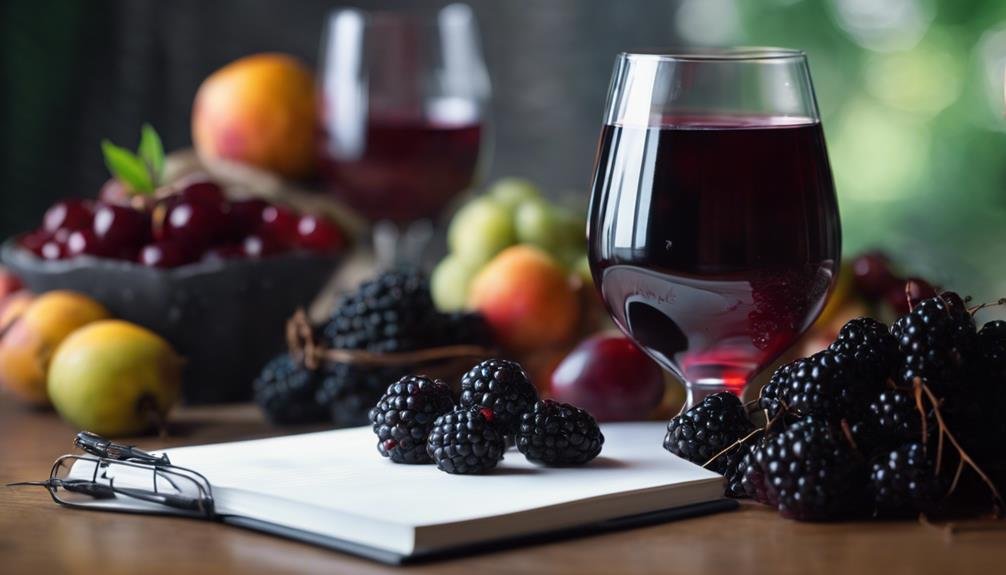Deciphering red wine flavors involves recognizing red fruit like cherries and raspberries, alongside black fruit notes such as plums, blackberries, and currants. Look out for floral aromas, herbaceous elements, and subtle pepper/spice undertones in your wine. Beyond taste, consider the complexities of the aroma, bouquet, and regional influences. Enhance your wine education by exploring aromas, flavors, and wine textures, understanding major wine styles. Each sip unravels a new layer of sensory experience, a true delight for your palate. Unravel the intricate tapestry of red wine flavors, an exploration that promises to uncover a world of nuances and delights.
Understanding Red Wine Flavor Profiles
Understanding the intricate flavor profiles of red wines requires a discerning palate and a keen appreciation for the nuances of red fruit, black fruit, floral aromas, herbaceous notes, and pepper/spice characteristics that define each varietal.
Delving into the flavorful notes of red wines offers a sensory experience that can be both complex and rewarding. The red fruit flavors can range from bright cherries to luscious raspberries, while black fruit notes may include plums, blackberries, or currants. Floral aromas add a delicate touch, herbaceous elements provide depth, and pepper/spice undertones create a harmonious balance.
Exploring these nuances enhances the sensory experience, allowing one to appreciate the craftsmanship and artistry behind each bottle of red wine.
Exploring Wine Characteristics Beyond Taste
Exploring the intricate characteristics of wine that extend beyond taste provides a deeper insight into the complex and multifaceted world of oenology.
Aroma complexities play a significant role in the sensory experience of wine appreciation. The bouquet of a wine encompasses a wide range of scents, from fruity and floral to herbaceous and spicy notes. These aromas can evoke memories, set the mood for a meal, or simply enhance the overall enjoyment of the wine-drinking experience.
Understanding the nuances of aroma profiles can help discerning enthusiasts identify different grape varieties, winemaking techniques, and regional influences. By delving into the sensory aspects of wine, one can truly appreciate the artistry and craftsmanship that goes into every bottle.
Enhancing Your Wine Education

To deepen your knowledge and appreciation of wine, expanding your wine education is essential. Enhancing your wine education involves delving into the sensory experience of wine, including aroma exploration to identify different scents like red fruit, black fruit, floral aromas, herbaceous notes, and pepper/spice undertones.
It also entails developing your palate by understanding flavor perception, allowing you to distinguish between various taste profiles and textures in wine. By learning about different wine types, exploring glassware and serving techniques, and understanding the major wine styles, you can elevate your wine education.
This process not only enriches your wine knowledge but also enhances your overall enjoyment and appreciation of this complex and fascinating beverage.
Frequently Asked Questions
How Does the Aging Process Affect the Flavor of Red Wine?
The aging process in red wine impacts flavor through oak influence, enhancing complexity and imparting vanilla or spice notes. Tannin structure evolves, smoothing out harshness and improving aging potential. This transformation results in a more nuanced and balanced wine profile.
What Are Some Common Misconceptions About Red Wine Flavors?
Misconceptions clarified: Red wine flavors often misconstrued due to tannin, acidity, alcohol, and sweetness. Understanding flavor profiles essential – red fruit, black fruit, floral aromas, herbaceous, pepper/spice. Educate on basic wine traits for accurate perception.
Can the Same Red Wine Taste Different When Paired With Different Foods?
The same red wine can exhibit varied flavors when paired with different foods. Flavor pairings influence taste perception as foods interact with wine on the palate. Palate differences due to food influence can enhance or alter wine tasting experiences.
Are There Specific Regions Known for Producing Certain Red Wine Flavors?
Certain regions are renowned for producing red wines with distinct flavor profiles due to soil influences. Terroir plays a significant role in shaping taste notes, where Bordeaux yields earthy wines, Burgundy offers elegant Pinot Noirs, and Napa Valley showcases bold Cabernets.
How Can Temperature Impact the Perception of Red Wine Flavors?
Temperature influence plays a vital role in the sensory experience of red wine. Serving conditions impact flavor perception greatly. Cooler temperatures can emphasize acidity and tannins, while warmer temperatures can enhance fruitiness and mask harsher components, altering overall taste profiles.
Conclusion
In the vast world of red wines, deciphering flavor profiles is like discovering a hidden treasure trove of sensory delights. Just as a skilled detective unravels clues to solve a mystery, exploring the nuances of red wine flavors requires patience, curiosity, and a discerning palate.
Each sip reveals a story waiting to be uncovered, inviting you on a journey of discovery and appreciation for the artistry of winemaking. Cheers to the endless possibilities that await in every glass!